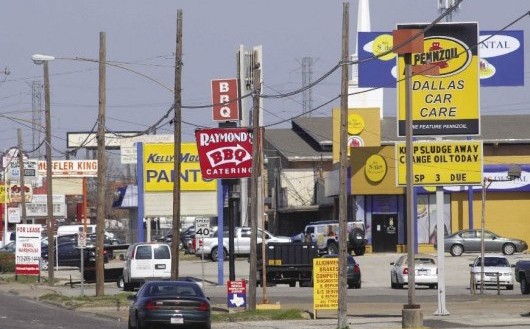Garland Road is home to some of the most beautiful and unattractive parts of Dallas

Garland Road accesses some of the most beautiful and culturally rich aspects of Dallas — White Rock Lake, the Dallas Arboretum, Samuell-Grand Park.
But it also contains a few things some people would like to sweep under the rug — vacant buildings, ugly signs, maddening traffic.
Residents and business owners in the area wanted to create a plan for the Garland Road corridor between East Grand and Interstate 635 that would allow it to grow and change in a way they all would like.
That’s how the Garland Road Vision study came to be. Stakeholders met over several years to hammer out recommendations that the city Plan
Commission could use as a guide for new developments along Garland.
Private donations totaling $30,000, plus $120,000 from the North Texas Council of Governments, allowed the study’s advisory committee to hire architectural firm HOK Consultants to oversee the project. The consultants are fine-tuning the recommendations and expect to bring them to the Plan Commission this summer. From there, it will go before city council.
“We hope it will be adopted by the city council,” says Lakewood resident Gerald Worrall, the advisory committee chair. “Then it becomes a tool that city planners can use that will serve as a guideline for what’s consistent with what the community wants.”
Recommendations fall into three categories: land use, transportation and beautification. Neighbors were clear during the study that they want low-density development. Although neighbors would like to see new mixed-use urban developments, such as a residential over retail setup, they don’t want Turtle Creek-style high-rises around the lake. And they want to keep wide setbacks, so a developer couldn’t build something that comes right up to the street.
The recommendations include using beautification to achieve unity throughout the corridor. Sure, the lake and the Arboretum look terrific, but just past Peavy Road, the landscape changes, literally.
“There were some great ideas to use landscaping and light fixtures that you would see around the lake and at the Arboretum to pull it all together,” says Worrall, who is also an architect. “If you repeat design elements, then it makes it more cohesive.”
Most neighbors think the area should be a destination for people throughout the region.
“It has great potential, but it drastically needs to be cleaned up,” says Bruce McShan of McShan Florist, which has been a Garland Road fixture since 1948. “It needs to be made a more appealing and welcoming area like Uptown or Turtle Creek. Those are areas where no one wanted to be 15-20 years ago, and now they’re destinations.”
Becoming a regional destination would require alleviating some of the traffic along the corridor. Several transportation alternatives were tossed around — light rail and streetcars being the most prominent.
In the end, they found one simple solution to alleviate some traffic: Making sidewalks continuous throughout the corridor would allow DART buses, which currently make about 70 stops along either side of Garland Road, to make about half as many stops.
“Of course, when the buses are stopping less frequently, that alleviates a lot of the bottlenecking,” Worrall says.
Not everyone was in favor of creating more sidewalks, and there are some who don’t want that part of the neighborhood to become a destination, says Aren Cambre of Lake Park Estates, who was on the Garland Road Vision advisory committee.
“You get a crowd who thinks as though the lake is their own backyard, and they don’t want to share it,” Cambre says.
Building continuous sidewalks could make it easier for people to park in Little Forest Hills, say, and walk to the Arboretum, where parking costs $7. Residents, however, probably wouldn’t be fans of parked cars clogging neighborhood streets.
There has to be some compromise with neighbors, Cambre says.
“Whatever happens, I hope it is a is a reasonable compromise between zoning and regulations to get the kind of improvements and good development that we want and not put us in a straightjacket as far as zoning,” he says.
The plan also makes recommendations for framing Garland Road at Interstate 635 and East Grand and Gaston avenues. The Gaston intersection would be the most immediate to become a gateway area for Garland, with access to the Santa Fe Trail opening soon and the spillway project almost completed.
There are also suggestions for art projects, landscape designs and signage to denote the Garland Road gateways.
Now that the planning stage is nearing completion, advisory committee members want to keep it going in some capacity to foster the vision.
“There is some room for an advocacy group to come in and do some work,” says Bob Weiss of Lakewood, who was on the committee. “It could work much like that Fort Worth Avenue (Development) Group in Oak Cliff.”
Many ideas in the plan for Garland Road, particularly the non-glamorous things like roadway improvements and other infrastructure, will require bond money.
“And who knows when that will happen,” Weiss says. “But it’s a very practical plan that could be implemented if there was funding.”
The purpose of creating a “vision” for Garland Road is that it’s an attractive corridor for developers. Portions might be somewhat seedy right now, but over the next several decades, the area could become a hotspot for real estate development.
Neighbors along the corridor want to be ready for that.
“Density is part of the plan, but it is controlled density,” says Mary Griggs, who has lived in the Emerald Isle neighborhood for 15 years and was present five years ago when developer Emerald Isle Partners announced plans to build a 24-story condominium tower on the lake’s east bank. The city council denied the rezoning request to allow that much height, and the development never materialized.
“You can’t just come in and throw up some building,” Griggs says. “We want to keep this a pleasant, low-key area to live and work and shop.”
Weiss, who lives in Lakewood, says the future of Garland Road affects all of central Dallas, and he’s excited about what’s to come.
“What the vision tries to do is talk to the possibilities of how it could look, how it could potentially be rezoned and how it could possibly get a different mix of retail and housing,” he says. “The vision that we’re coming up with is a very powerful one.”





